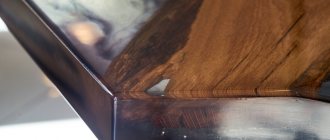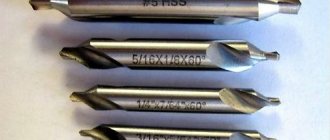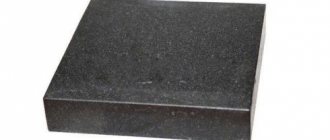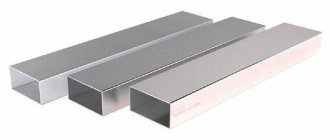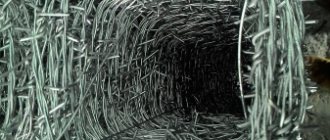Maintenance of structural, working parts and parts of equipment, as well as tools, is a prerequisite for their effective use, as well as long-term operation. For this purpose, diamond polishing paste for various hard materials is most often used. When ready for use, it is an emulsion with a fine structure. Thanks to its properties, it acts chemically and mechanically on the surface being processed, allowing high-quality polishing or finishing of structural and metal parts. It can be almost any alloy. Can be used with the same effectiveness on minerals (stones) and glass.
reference Information
DocumentsLawsNoticesDocument approvalsContractsRequests for proposalsTechnical specificationsDevelopment plansDocument managementAnalyticsEventsCompetitionsResultsCity administrationsOrdersContractsExecution of workProtocols for consideration of applicationsAuctionsProjectsProtocolsBudget organizationsMunicipalitiesRegionsEducationsProgramsReports
by mentionsDocumentary baseSecurities
Regulations
Financial documents
Resolutions
Categories by topicFinancecities of the Russian Federationregions by exact datesRegulations
Terms
Scientific terminologyFinancialEconomic
Time
Dates20152016Documents in the financial spherein the investment sphere
WHAT TO DIVIDE
Before use, GOI polishing paste requires preliminary softening. In its initial state, the paste can be quite dry, which will make it difficult to apply to a polishing cloth, and hard lumps will lead to the formation of unnecessary scratches on the glass during processing.
The list of liquids used to soften the material is quite extensive: from distilled water, industrial and motor oils to white spirit and purified gasoline for lighters.
It is not recommended to dissolve GOI paste with gasoline or white spirit due to their flammability, and then it is difficult to neutralize the specific pungent odor of these liquids. The following method is more practical:
- Apply a small amount of motor oil to a block of GOI solid paste using a syringe or pipette;
- the liquid is rubbed into the block using flannel or cotton cloth until the paste has a consistency similar to plasticine;
- With the resulting plastic mass, you can polish defective areas of glass or headlights without the risk of damage.
For greater homogeneity, the mixture of GOI paste with motor oil can be heated before use (for example, in the microwave) and mixed thoroughly.
Tip! Prepare the polishing mixture in batches. Over time, the liquid evaporates and the paste becomes solid again.
The glass or plastic surface to be treated must also be moistened with water and lubricated with industrial or motor oil. If you apply GOI paste on dry glass, there is a high probability that the outer layer will become dull.
Diamond paste for glass polishing
A number of glass products are subject to increased requirements related to optical characteristics, transparency, and surface quality. These are automobile glass and glass for headlights and car lamps, glass products used in the production of optical instruments, various reflectors, mirrors, etc.
To increase the smoothness of the surface and improve the quality characteristics of glass, polishing agents are used. One of them is diamond glass polishing paste.
Why is glass polishing needed?
The use of polishing compounds allows you to achieve the following results:
- increase the smoothness of the glass surface;
- eliminate the consequences of exposure to negative external factors - dust, dirt, stones, branches, sand, precipitation, aggressive chemical compounds, etc.;
- mask or eliminate small roughnesses, cracks, abrasions;
- protect glass from damage;
- increase the transparency and optical properties of glass;
- restore the original shine and give the glass surface a more aesthetic appearance.
Types of diamond polishing compounds
The paste contains microparticles of synthetic diamond dust, which have an abrasive effect; they actively interact with the glass surface not only mechanically, but also chemically, and during processing they remove scratches from it, allow you to level the surface and eliminate unevenness.
In addition to diamond grains, the paste contains binding compounds - stearin, paraffin, olein or other substances.
Diamond paste is produced in the form of ointments of varying degrees of softness, as well as in solid and powder form.
The pastes contain 12 types of diamond grains, differing in size. There are large types of grains, medium, small, and for the most gentle processing, thin grains are used.
Depending on the type of grains included in the paste, its purpose also differs - different types of compositions are used for roughing, preliminary surface preparation, fine finishing, pre-polishing and finishing.
Pastes also differ in the concentration of abrasive substances - compositions with normal, increased and high concentrations of abrasives are distinguished. They are marked, respectively, with the letters N, P and V.
Another difference between pastes is related to the binders used and the method of removal - some pastes are removed after treatment from the surface only with water, some with gasoline, some with other solvents.
Types of funds
Depending on the type of rinsing, pastes are divided into:
- aquatic (B). They are washed off with water and do not contain fat;
- fatty, organic (O). They are resistant to aqueous solutions. Such mixtures contain paraffin, various oils and fatty acids. They can be diluted with industrial oils and washed off with kerosene, alcohol or gasoline.
GOI paste in the form of a bar.
Polishing pastes are divided depending on the condition into:
- solid (in powder or bar form). Requires dilution with water or other means;
- liquid (in the form of ointment).
You can find the following types of diamond products on the market:
- universal. Such mixtures are equally suitable for any materials;
- specialized. Only suitable for metal alloys, stone or glass.
There are 12 types of grain sizes, which are divided into large, medium, small and fine. Depending on the degree of granularity, substances can be used for:
- draft;
- preliminary;
- precise finishing;
- pre-polishing;
- for final polishing.
Characteristics of diamond pastes
If the abrasives contained in the paste are cubic boron nitride, they are called cubanite polishing or CBN pastes.
They are applied under a polishing wheel. They are selected depending on the parameters of the circle or the type of product.
The concentration of abrasives divides all diamond mixtures into:
- with normal grain concentration (N);
- with increased grain size (P);
- with high grain size (B).
There are 2 brands of synthetic diamonds for the manufacture of powders and ointments - the ASN or ASM brands. In addition, grinding powders with low strength (AC4) can be used for their manufacture.
Types of Diamond Polishing Pastes
Another classification divides substances into:
- type "G". They are washable with organic solvents and are intended for processing ferrous and non-ferrous metal alloys, as well as non-metals and semiconductors;
- type "L". Washable with most solvents. Process cast iron, alloy steel and other hard alloys;
- type "X". They can be washed off with water, but they are not amenable to solvents. They can process car glass, as well as semiconductor parts;
- type "E". Can be washed off using universal solvents and are also used for glass.
On sale you can find the product in cases, syringes or jars (depending on consistency and volume).
Definition of the concept of “polishing” and its types
By polishing, experts understand a method of processing metal that allows you to restore the shine of the metal surface. Today the following grinding methods are actively used:
- Hand polishing. It is used mainly during repair work.
- Mechanical polishing. Involves the use of special polishing wheels mounted on a polishing machine.
- Machine method. Common in large enterprises. To give the surface of the product an aesthetic appearance, a polishing machine is used.
- Water jet grinding on special machines. This technology is used only when it is necessary to process a large number of products. The method has much in common with plasma and chemical-mechanical polishing, which are based on a similar principle.
In the case of mechanical polishing, the following devices are most often used:
- Drills with clamps.
- Electric sharpener.
- Grinder machine.
- Polishing machine.
The processing method under consideration has several key advantages:
- This finishing method allows you to select the desired rotation speed of the circles and belts, thereby improving the quality of processing of the metal plane.
- The polishing machine can work not only with factory wheels, but also with additional attachments, which can be made of a wide variety of materials - wool, leather, fabric, etc.
When using a manual finishing method, it is impossible to guarantee consistently high efficiency, as is the case with an automated method. It all depends on the quality of the polishing materials used. The work is performed using diamond paste and additives based on chromium or iron oxide. To process smooth surfaces, a kind of file is used, which is a wooden block covered with fabric, onto which a layer of polishing paste is applied.
Areas of application of diamond, CBN pastes, GOI pastes
Pastes are used for processing alloys, metal and non-metallic surfaces:
- various metals;
- alloys;
- stone;
- porcelain and ceramics;
- glass;
- precious and artificial stones;
Polishing machines and grinding wheels are used for work; manual processing is also allowed.
Classification of polishing pastes
To give the surface of metal products a mirror look, it is not necessary to resort to the help of machines. You can do everything yourself. The main thing is to choose the right special tools, which can be presented in the following groups:
- Aquatic. Fat-free pastes. Provide excellent results when following the instructions for their use.
- Organic. They contain paraffin and various oils. They are used only in diluted form, for which they are mixed with various oils and fatty acids.
- Diamond paste. A radically new product with which you can quickly add shine to any surface.
Diamond paste
Among all the above listed compositions, the last polishing option deserves the most attention. With the help of paste you can achieve such amazing results that there is no need to even use a polishing machine. This composition for processing metal products is today available in two versions: ASN and ASM brands (expensive).
Diamond paste is very popular among many home craftsmen due to the following advantages:
- Accuracy. Thanks to the synthetic diamonds included in the composition, you can polish any metal product to a high shine with a high degree of precision.
- Wide range of grain sizes. Pastes with more than 12 types of grit are offered for sale.
- Easy to use. Each craftsman can perform surface finishing independently, without resorting to the help of a special tool.
- To process metal products, you need the most common equipment - a rag, water and a pair of rubber gloves.
But for all their advantages, these pastes have a serious drawback - their high price. Purchasing such a product to give an aesthetic appearance to a metal product will cost no less than 500 rubles. for 35 grams of substance.
Principle of operation
The required effect as a result of the use of diamond paste is achieved due to its action on the surface by chemical or mechanical means, which ultimately leads to the formation of a dispersed film on it. Products for finishing metal products contain special active substances that accelerate the occurrence of adsorbing processes, so that material grinding can be performed as efficiently as in a factory environment, with the same time costs.
Advantages
This paste interacts well with all types of materials - stone, plastic, rubber and paper. If necessary, polishing wheels can be additionally lubricated with a similar composition to increase the efficiency of finishing the metal surface. All this only has a positive effect on the quality of processing and allows you to achieve a mirror effect. In the latter case, processing is carried out using circles made of special materials - leather, felt and felt.
Advantages and disadvantages
Products for treating glass and other automotive surfaces with the addition of diamonds have the following advantages:
- accuracy. The synthetic diamonds contained in the mixture will most accurately polish any surface, bringing it to the desired smoothness;
- Wide range of abrasiveness levels. There are 12 grit types that are suitable for any type of work;
- the ability to work with the material yourself. It is not necessary to go to a service station to polish glass or metal surfaces.
Where is resin used?
Epoxy resin is a universal adhesive that hardens to a monolithic state. This material is familiar to many. Fiberglass impregnated with epoxy reinforces the bottoms of small boats and large ships. In the industrial sector, resin is used as a binding component in the manufacture of composite finishing tiles, slats, and deck boards.
In its pure form, the resin is used to create glossy transparent surfaces. After polymerization it acquires high density.
In its pure form, the resin is used to create glossy transparent surfaces.
In jewelry, polishing makes it possible to create real works of art. During processing, it acquires a noble appearance and retains its decorative effect for a long time. The two-component adhesive composition firmly adheres to the base, the resulting layer does not crack when drying due to changes in the internal structure.
Epoxy resin, poured into molds, after polymerization lends itself well to mechanical processing: cutting, grinding. In its solid state, the surface of a table filled with epoxy is comparable to artificial stone. The floors are poured with a polymer adhesive mixture. After processing, the resulting layer becomes transparent, through which the structure of the solid wood is clearly visible. The surface quality of finished products depends on what the epoxy resin is polished with.
In jewelry, polishing makes it possible to create real works of art.
Combined processing methods
To give the surface of a product the necessary characteristics, it can be processed using combined methods, especially if we are talking about an unprepared and rough surface with rough relief. Most often, the choice is made on long-term electrolyte-plasma finishing, which involves removing a significant layer of metal.
This finishing method is used only in extreme cases, when it is necessary to restore the shine of a metal product in a short time. The main disadvantage of this processing method is its high energy intensity, which is especially clearly visible at the initial stage, when 100% more energy is consumed than usual.
The work itself on finishing a metal part using an electrolyte-plasma polishing machine takes place in two stages. First, the surface is degreased, and then proceed directly to grinding, which consists of two cycles: in the first, the rough layer is cut off, and in the second, grinding of the surface begins. Each product must first be degreased, since upon contact with a viscous surface there is a high probability of metal oxidation and deterioration in the quality of its finish.
SAFETY REQUIREMENTS
7.1. Substances below hazard class 3 according to GOST 12.1.007-76 should not be used as binding components.
7.2. When working with electrical equipment, it is necessary to comply with the general requirements for safe work in accordance with GOST 12.2.007.1-75.
7.3. When working with flammable substances, it is necessary to comply with the general requirements for safe work in accordance with GOST 12.1.004-85*. ______________ * GOST 12.1.004-91 is in force on the territory of the Russian Federation. — Note from the database manufacturer.
7.4. Personnel working with pastes must have:
work coat according to GOST 12.4.131-83 or GOST 12.4.132-83;
apron according to GOST 12.4.029-76;
scarf made of cotton fabric according to GOST 7138-83;
protective hand cream.
7.3, 7.4. (Changed edition, Amendment No. 2).
Ways to remove scratches
Whichever glass restoration option is chosen from those proposed, be sure to wash the scratched surface before polishing. Next, be sure to wipe it dry.
Now let’s look at all the ways to remove scratches and abrasions of different types of glass.
Toothpaste
Toothpaste must have a whitening effect. It's more potent. You will also need cotton pads, with the help of which the paste will be applied.
A small amount of whitening toothpaste should be squeezed onto the disc and pressed firmly onto the damaged area for a few seconds. After this, polish the scratched area in a circular motion, first in one direction, then in the other direction. Thus, a kind of cleaning of the defect occurs.
Actions must be carried out until the desired result is achieved. After this, the product is wiped off excess paste with a soft towel and washed with clean water.
Anti-Scratch Product
You can purchase this particular product or another similar one at a car store. This polish is specially created to combat shallow and medium-depth damage. Anti-Scratch can be used on both thin and thick glass.
How to polish scratches with it? Apply the required amount of the substance to a soft cloth and vigorously polish the glass. After this, wipe it with a clean napkin. More detailed information about use can be read directly on the tube with the product.
Paste GOI
GOI paste is also not a little-known product. You can even use it to remove scratches from a glass table. All that is required is to warm the paste a little (in a water bath) and treat the problem area with a cotton swab or soft cloth.
After actively rubbing the scratch with GOI paste, the glass will be perfectly polished, and not a trace will remain of the defect. You can use this paste both for gadget screens or watches, and for car windshields or ordinary windows.
Vegetable oil
This method is suitable for masking only the most minor scratches. It is recommended to use vegetable oil for small products. For example, to remove scuff marks on the glass of watches, phone screens, glasses, key fobs, etc.
You just need to pour any vegetable oil (sunflower, corn or olive) onto a flannel napkin and rub the scratch vigorously until it is perfectly polished. The screen will shine like new again, and the abrasion will not be as noticeable.
Dry mustard with vinegar
The use of the products is very simple. We get rid of small scratches like this: mix the ingredients in such proportions to obtain a thick consistency, like toothpaste. After which the resulting mixture is applied, for example, to the glass of glasses using a cotton pad, and intensively polished.
After the defect has been removed, wipe the glass product well with a clean damp cloth.
Clear nail polish
To remove shallow scratches on household glass products, it is good to use nail polish. It must be colorless.
It’s even better to choose not ordinary varnish, but “Smart Enamel” nail hardener. It adheres more firmly to the glass surface and looks almost invisible.
Before application, you need to not only wash the surface, but also degrease it. You can use nail polish remover or regular acetone.
It is necessary to carefully cover the scratch with varnish, and try to fill it without going beyond the limits. If, after all, the product has touched the entire surface, then this problem can be solved using a rubber spatula or other non-solid auxiliary tool
Excess varnish should be removed only after it has completely dried.
Description and properties of the polishing process
GOST 9.301-86 regulates the requirements for the quality of processing of metal products as a result of polishing work. There are no special instructions regarding the gloss of surfaces after grinding, however, after polishing various defects, grooves, scratches, burrs, corrosion, etc. should be excluded.
In production there is such a thing as “polishing class”. The level of surface roughness of a particular part is determined using special equipment (microscopes and profilographs) down to 1 micrometer (μm, 1 mm = 1000 μm). If metal grinding is carried out at home, then the depth of the unevenness is determined by eye.
There are 14 roughness classes, which are indicated in special drawings in accordance with GOST 2789-59.
Polishing classes and requirements for them are presented in the table below.
| Surface description | Roughness size (up to microns) | Polishing class | Mechanical processing method |
| Traces of processing are very noticeable | 320 | 1 | Planing, sharpening and milling |
| 160 | 2 | ||
| 80 | 3 | ||
| Traces of processing are very faintly visible | 40 | 4 | Soft abrasive, semi-finishing |
| 20 | 5 | ||
| 10 | 6 | ||
| Traces of processing are not visible at all | 6,3 | 7 | Fine flow, grinding |
| 3,2 | 8 | ||
| 1,3 | 9 | ||
| The surface of the metal product is perfectly smooth and has a characteristic mirror shine | 0,8 | 10 | Final polishing, soft polishing |
| 0,4 | 11 | ||
| 0,2 | 12 | ||
| 0,1 | 13 | ||
| 0,05 | 14 |
TEST METHODS
4.1. Test methods for pastes must comply with those specified in Appendices 1-4.
4.1.1. Determination of the consistency of pastes - according to Appendix 1.
4.1.2. Determination of the abrasive ability of pastes made from grinding and micropowders - according to Appendix 2.
4.1.3. Determination of the surface roughness parameter treated with micropowder pastes - according to Appendix 3.
4.1.4. Determination of the removal rate and surface roughness parameter treated with pastes made from submicropowders - according to Appendix 4.
Diamond pastes
In the production of diamond polishing and finishing pastes, fine (1-40 microns) diamond powders are used. Materials that contain both artificial (synthetic) and natural diamond grains are common. Under certain conditions, the performance of synthetic diamonds will exceed that of natural diamonds. This effect is explained by the special nature of the grain surface, high homogeneity and, as a result, better fixation.
According to grain size, diamond pastes are divided into micropowders (denoted by the letters AM) and powders (denoted by the letter A). When using synthetic diamonds, the letter “C” is added to the marking (example: ASM40, AC 16).
Diamond pastes used for finishing are applied to the laps. The highest performance efficiency is shown by a material consisting of 30-40% diamond powder and 70-60% castor or olive oil.
The pastes are produced in ready-to-use form and are divided into four groups and twelve grain types. For ease of identification, the packaging is painted in different colors, and the material itself is light - this allows you to control the amount of coating removed.
The concentration (weight content) of diamond powder depends on its grain size and belongs to one of three groups:
- N – normal;
- P – increased;
- B – high.
The higher the hardness of the surface being treated, the larger the grain size of the paste used. Most often, diamond paste is packaged in tubes weighing 80, 40 or 20 g.
ACCEPTANCE RULES
3.1. To verify compliance of diamond pastes with the requirements of this standard, acceptance inspection and periodic testing are carried out.
3.2. Acceptance control for compliance with the requirements of clause 2.4; 2.5 and clause 2.7, samples of each batch of pastes must be tested.
The batch must consist of a paste of the same composition, obtained in one technological cycle from the same grade and grain size of diamond powder, simultaneously presented for acceptance according to one document.
(Changed edition, Amendment No. 2).
3.3. If during acceptance control it is established that there is non-compliance with the requirements of the standard for more than one of the controlled indicators, then the batch is not accepted.
If non-compliance with the requirements of the standard is established for one of the controlled indicators, then repeated control is carried out on a double number of samples for all indicators.
If there are defects in the re-sampling, the batch will not be accepted.
3.4. Samples of any batch of pastes must be subjected to periodic testing for compliance with the requirements of clause 2.2 at least once every 6 months.
(Changed edition, Amendment No. 2).
Section 3. (Changed edition, Amendment No. 1).
Polishing Features
The use of the paste-like substance GOI has many nuances. For example, many drivers have a question: do they need to dilute the paste-like substance with something? It is known to be quite hard and dense. The answer to this question is: it is possible and even necessary. In order to easily apply the product to a rag, you need to make it more liquid using machine oil. It is added at the rate of a few drops per small piece of product.
Preparation of a solution from GOI paste
If you decide to polish the plastic surfaces of your car, use the softest cloth (flannel or cotton). To process a metal body, you can take a coarser fabric: jeans, felt or tarpaulin.
The polishing process involves the following stages with their features:
- Before starting work, it is necessary to degrease the surface with shampoo, alcohol or glass cleaner. This will give a positive result when polishing;
- If there are scratches on the windshield, rear window or headlight, it would be much better to remove them using an electrical device, since doing it yourself will not give the desired effect. Carrying out all the processes manually will not only take you several hours, but will also make it possible to remove only the haze of the headlights. A polishing machine, unlike doing it yourself, does the same amount of work in half an hour;
Polishing with GOI paste using a drill
- you need to prepare the workplace (remove dust from nearby surfaces - it can interfere with work);
- The substance should be applied to a small area of the windshield, headlight or body. Only after thoroughly rubbing the product into the surface can you move on to the next area;
- After finishing work, you need to wash the headlights or the car body again, using non-contact foam (if grinding was carried out) or strong water pressure (for regular polishing).
High quality of our diamond pastes
Our diamond pastes, which you can buy at a minimal price, are intended for the following types of profile work:
- carrying out polishing and grinding work on hard materials;
- a procedure for finishing metal alloys and non-metallic materials as part of a separate tool, piece of equipment, or even an artistic item.
Read more: How to make double glazing
Our diamond paste fully complies with the established technical quality standards established in Russia and the CIS countries. First of all, this is great news for those who process expensive materials and bear great financial responsibility for the quality and speed of the manipulations performed. With our diamond paste you can always count on a positive result.
Our products are color coded depending on the grain size. Such a visual indication is necessary to determine the required position of the product, depending on the nature of the work to be done and the characteristics of the material being serviced.
Our diamond pastes, the purchase of which will be profitable for both a small private workshop and a large industrial enterprise, are characterized by:
- absolute mechanical stability;
- high resistance to increased thermal contact when it is necessary to treat heated surfaces over a long time interval. The quality of the paste’s effect on the object is practically not reduced;
- high speed of removal of the surface layer of the serviced material;
- ideal surface parameters after treating it with paste.
Pastes used for polishing, sanding, finishing and other final finishing applications are made from micro- or abrasive powders. Such materials have an abrasive effect, and the treated surface receives the necessary roughness.
The surface substances contained in the pastes actively remove microchips and other elements remaining after previous processing. The material has a paste-like consistency containing microscopic diamond particles. The surfactant compounds included in the composition ensure rapid removal of chips, slag, flammable liquids and ensure ease of washing. Such characteristics improve quality and reduce processing time.
APPENDIX 6 (recommended). AREA OF APPLICATION OF PASTES DEPENDING ON GRANDS OF DIAMOND POWDERS
APPENDIX 6 Recommended
| Brand of diamond powder | Recommended application |
| A2, A3, AC2 | Grinding, rough finishing of various materials |
| AM, ASM, AN, ASN | Polishing, finishing, fine polishing of various materials (alloys of ferrous and non-ferrous metals, non-ferrous metals, non-metallic materials) |
| AM1, ASM1, AM5, ASM5 | Fine polishing of metals, alloys, non-metallic materials |
Grinding technology
The process of grinding natural stone can be coarse or fine, depending on the result you plan to achieve. The simplest option is used when preparing building blocks, steps, and paving stones. In this case, rough grinding is sufficient to obtain an even, geometrically correct shape of the material without a mirror shine or smoothness. You can achieve this result using a grinder and a diamond cup.
Regardless of the choice of method, work with stone must be carried out outdoors or indoors with forced air outflow and high-quality filtration systems. The eyes and respiratory organs must be protected from contact with fine particles of minerals and rocks. It is also recommended to periodically clear the surface of the instrument from dust.
Simplified grinding technology is carried out in several stages.
Formation of an even cut. At this stage, all geometric imperfections of the workpiece are removed. You can remove excess and eliminate defects using a grinder or a special machine.
CBN pastes
Elboron pastes are called pastes in which cubic boron nitride acts as an abrasive. Another name for them is cubanite polishing pastes. This type of paste is intended for finishing and sharpening metals and metal-cutting tools made of alloy steels, and polishing glass surfaces.
The surfactants included in the material not only remove waste chips, flammable liquids and slags from the working area, but also increase the performance of parts. Ensuring they are washed. Thanks to this, the polishing process occurs with absolute precision, and the paste has a positive effect on the surface being treated.
CBN pastes are divided into several types, which determine the scope of application:
- type G (POMG, VOMG and NOMG) is used for polishing and processing steel, non-metallic and non-metallic surfaces, semiconductor materials and various alloys;
- type L (POML, VOML, NOML) is used for processing and polishing ceramics, cermets, hard alloys, sapphire. Ferrite, cast iron and steel surfaces;
- type X (POMX, BOMX, NOMX) is intended for polishing carbide and glass surfaces, processing die and semiconductor materials;
- type E (POME, VOME, NOME) polishes carbide and glass surfaces, processes semiconductor materials.
The degree of granularity of CBN paste depends on the size of the microparticles, which differs depending on the purpose:
- grain size 125/100—50/40 – for rough finishing and roughing;
- indicators 40/28, 60/40 – less rough finishing during roughing;
- grain size 14/10-28/20 – preliminary finishing stage;
- grain size 5/3-10/7 – for precise finishing;
- pastes with a grain size of 1/0-3/2 – preliminary polishing stage;
- Grit value 0.1/0-1/0.5 – final polishing.

